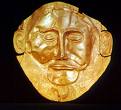|
Bronze Age Mycenae
Clicking on the thumbnail will open a new browser window.
|
Mycenae, the legendary home of Clytemnestra and Agamemnon, reached the peak of its prosperity during the late Bronze Age, 1650-1200 BCE. Its defensible position on a hill surrounded by two ravines, its close proximity to a spring and the surrounding fertile countryside, and its location on a major road connecting two coasts made it a good location for a major Bronze Age center. In this photo, you can see the fertile plain of Argos below the citadel. |
|
Archaeologically, the first indication of the wealth and power of Mycenae's rulers can be found in two massive grave circles (1650-1500 BCE). Grave Circle A, originally outside the fortifications, contained six deep shaft graves surrounded by a parapet wall that surrounded the graves and marked off the space.
|
 |
Buried in the six graves were only 19 men, women, and children. Accompanying their bodies at the bottom of each shaft were spectacular grave offerings. Among the sumptuous offerings were more than 30 pounds of gold, including five gold masks, and imports from around the Aegean Sea. Here you can see the so-called mask of Agamemnon, who lived three centuries later. An infant buried in Grave Circle A was completely covered in sheet gold; this infant did not earn his loot, but was ascribed power through birth. |
|
In the 15th century, the leaders of Mycenae developed even more elaborate burial spaces called tholos tombs. These monumental tombs, shaped like beehives, were built partially into the earth and then covered with more earth to form a burial mound. This image shows the dromos, the monumental approach to the tomb. |
|
Each tomb consisted of three parts, the dromos (walkway pictured previously), the stomion (mouth or entrance), and tholos (the round enclosed burial chamber). In this picture, you can see the special kind of vaulting that the Myceneans employed called corbelling. |
| |
|
|
In the mid 14th century, the people of Mycenae expanded the palace, leveled and terraced the hilll, and created the first fortification walls made of such enormous stones that visitors ever since thought they were the work of the Cyclopes. A century later (c. 1250 BCE), the fortification walls were expanded to include Grave Circle A. At the same time, a new gate was built, now called the Lion Gate. |
|
The Lion Gate is so named because on it are perched two lionesses on either side of a single column, resting their paws on two altars. The imagery of lions, central column, and altars must have sent a message of royal rule by the leaders of the citadel. |
|
After passing through the Lion Gate, visitors walked past the newly enclosed Grave Circle and then climbed a large ramp to the top of the hill to the palace. |
|
When they arrived, they would find themselves first in an open court. They would then be escorted through a small vestibule into the throne room with its magnificent hearth (pictured) supported by four columns. Painted on the walls were battle scenes and the floors were paved with gypsum slabs. |
Photo credit: Mask of Agamemnon, photograph by Thomas Sakoulas, Ancient-Greece.org.
Other photos on this page: John Gruber-Miller © 2012
|








